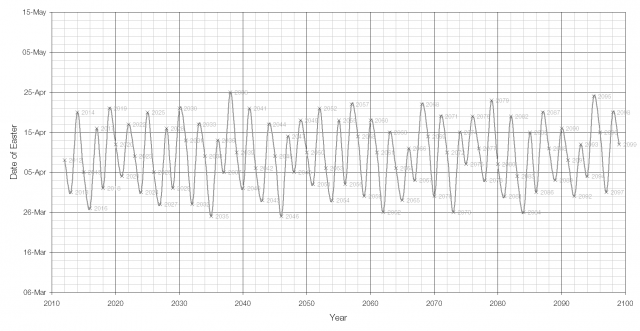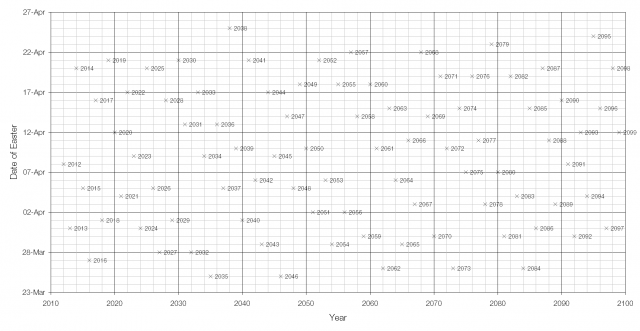You may have noticed that the date of Easter Sunday changes every year:
The date of Easter Sunday is calculated using a calendar that is based both on the Sun and the Moon* and takes place “on the first Sunday after the Paschal Full Moon”. Because the Gregorian calendar is based on the Sun only, the date of Easter changes from year to year.
The Paschal Full Moon is based not on an actual astronomical event but on historical tables established by a bunch of religious guys in 325AD, and its date can be up to ± 2 days from the actual astronomical Full Moon. The Paschal Full Moon is selected as the first of the Full Moons recorded in these tables to follow the March Equinox (also known as the vernal equinox as it is the day on which the night and day are the same length when heading into Spring in the northern hemisphere and coming from the Latin ver for spring).
When a line connecting adjacent dates is drawn a pattern becomes obvious, especially when the scale is compressed.
 The earliest Easter can possibly fall is March 22nd, though this is very rare, occurring most recently in 1818 and next in 2285. The next earliest date is March 23rd, as it was in 2008 and this will not happen again until 2160, by which time you will be dead.
The earliest Easter can possibly fall is March 22nd, though this is very rare, occurring most recently in 1818 and next in 2285. The next earliest date is March 23rd, as it was in 2008 and this will not happen again until 2160, by which time you will be dead.
The latest date Easter can occur is April 25th, which last occurred in 1943 and will next occur in 2038. The cycle for Easter dates repeats every 5 700 000 years exactly, and the most common date within that cycle is April 19th, occurring in 3.9% of cases. Easter moving around to the extent explained above is a real pain and in my opinion we should all just agree that from now on Easter Sunday is always the nearest Sunday to April 19th.
* Lunisolar calendars like this are used by many Jews, Buddhists, and some Hindus as well as those in Burma, China, Korea, Mongolia, Tibet and Vietnam.
